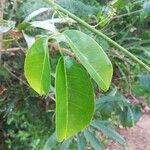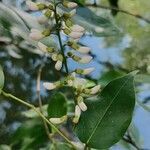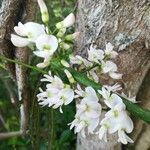Woody climber with twining branches, up to 3-15 m high. Branchlets subglabrous, brown with conspicuous paler raised lenticels. Leaves 8-21(-30 outside Africa) cm long; stipules triangular-ovate or subulate, 2-3 mm long, caducous; stipels setaceous, ± 1 mm long; leaflets 3-5(-7 outside Africa), lanceolate to ovate or elliptic, 5-11 (-15 outside Africa) cm long, 2.5-6.5(-7.5) cm wide, acuminate, rounded to the very slightly peltate base, shiny, fresh-green, subglabrous, with 8-14 very fine usually rather inconspicuous spreading lateral nerves on either side and fine reticulate venation. Panicles terminal and axillary, subracemose, with the flowers clustered on very short axes lateral from the simple rachis, 10-28 cm long, with only small scattered hairs; bracts lanceolate or ovate, 0.5-1 mm long, ciliate; bracteoles inserted near middle or on the upper part of the 2-4(-6) mm long pedicel, similar. Calyx shortly and broadly campanulate, subtruncate with the teeth scarcely distinguishable, ciliolate but otherwise subglabrous. Corolla white to very pale mauve, tinged pink, 9-12 mm long. Fruit ± kidney-shaped to subrectangular, rounded on the lower side, narrowly winged on the upper side, sessile, 3-4.5(-5.5) cm long, 2-3(-3.5) cm wide, pale, subglabrous or with scattered hairs towards base, venose, 1(-2 outside Africa)-seeded. Seeds oblong-reniform, mostly 1.5-2 cm long, wrinkled, brown.
Lianas, glabrous. Leaves (3 or)5(or 7)-foliolate; rachis 7-15 cm, including petiole 5-9 cm; leaflet blades ovate-oblong, 5-10 × 2-4 cm, firmly papery to subleathery, base rounded to slightly cordate, apex obtusely acuminate. Pseudoracemes axillary, 5-10 cm; rachis nodes with 2 or 3(-6) fascicled flowers sometimes borne on a short branchlet. Pedicel 2-4 mm. Flowers ca. 1.2 cm. Calyx campanulate, ca. 2 mm, glabrous or subglabrous; teeth very short, obtuse. Corolla whitish to pink, ca. 1 cm; standard suborbicular. Ovary sparsely pubescent. Legume obliquely ovoid, globose, or oblong, 2.5-4 × 2-3 cm, compressed, glabrous; adaxial suture with a narrow wing. Seeds 1 or 2 per legume. Fl. Apr-Aug, fr. Aug-Dec. 2n = 22.
Leaves up to 18 cm long; petiole 2.5–6.5 cm long, rachis 2–6 cm long; petiolules 2–5 mm long; leaflets 1–2(3) on each side of the rachis, 4–7(8) × 2.5–4 cm, ovate to elliptic, the terminal one the largest, thin and stiff to leathery, acuminate with the apex obtuse to subacute, rounded at the base, midrib flat above, prominent beneath; lateral nerves in 5–8-pairs, flat on both surfaces; stipules falling early.
A climber. It is a woody vine. They can be 4 cm across. The leaves are compound and usually have 3-7 leaflets. The leaflets are narrowly oval and 6-15 cm long by 3-8 cm wide. The flowering shoots are 7-10 cm long. The flowers are white to pink. They are 13 mm across. The fruit are flat and 4-5 cm long by 2-3 cm wide. They usually only have one seed. The seed is kidney shaped and 25 mm long by 18 mm wide.
Standard c.9 mm in diameter, quadrate-circular, broadly emarginate or retuse, with a 1.5–2 mm long claw at the base; wings obovate, adhering slightly to the keel below the middle, auriculate, with a claw c.2.5 mm long; keel petals sparsely puberulous towards the ciliolate auricle, claw c.3 mm long.
Flowers c.10 mm long, in triads on short lateral branches up to 5 mm long, single towards the axis top; pedicels 2–5 mm long, articulated at or near the base; bracteoles very small, present at anthesis, later deciduous.
Inflorescence 3–15 cm long, axillary, also borne on leafless stems; axis sparsely pubescent; bracts c.1 mm long, ovate-acute, sparsely pubescent.
Pod normally 1-seeded, 3–3.5 × 1.5–2 cm, flat, subreniform to subquadrangular, slightly reticulate, wing 1–1.8 mm broad; style persistent.
Stamen filaments 9–10 mm long, the lower 5–6 mm fused into a tube; anthers c.0.5 mm long, versatile.
Liane with twining stems up to 15 m or more high, glabrous except for the inflorescence.
Ovary 3–6-ovulate, subsessile, puberulous; style 6 mm long; stigma subcapitate.
Calyx 2–2.5 mm long, broadly campanulate, truncate and sparsely hairy above.
Seed 2.2–2.5 × 1.5 × 0.3–0.4 mm, subreniform with a red-brown testa.
Corolla pink.



